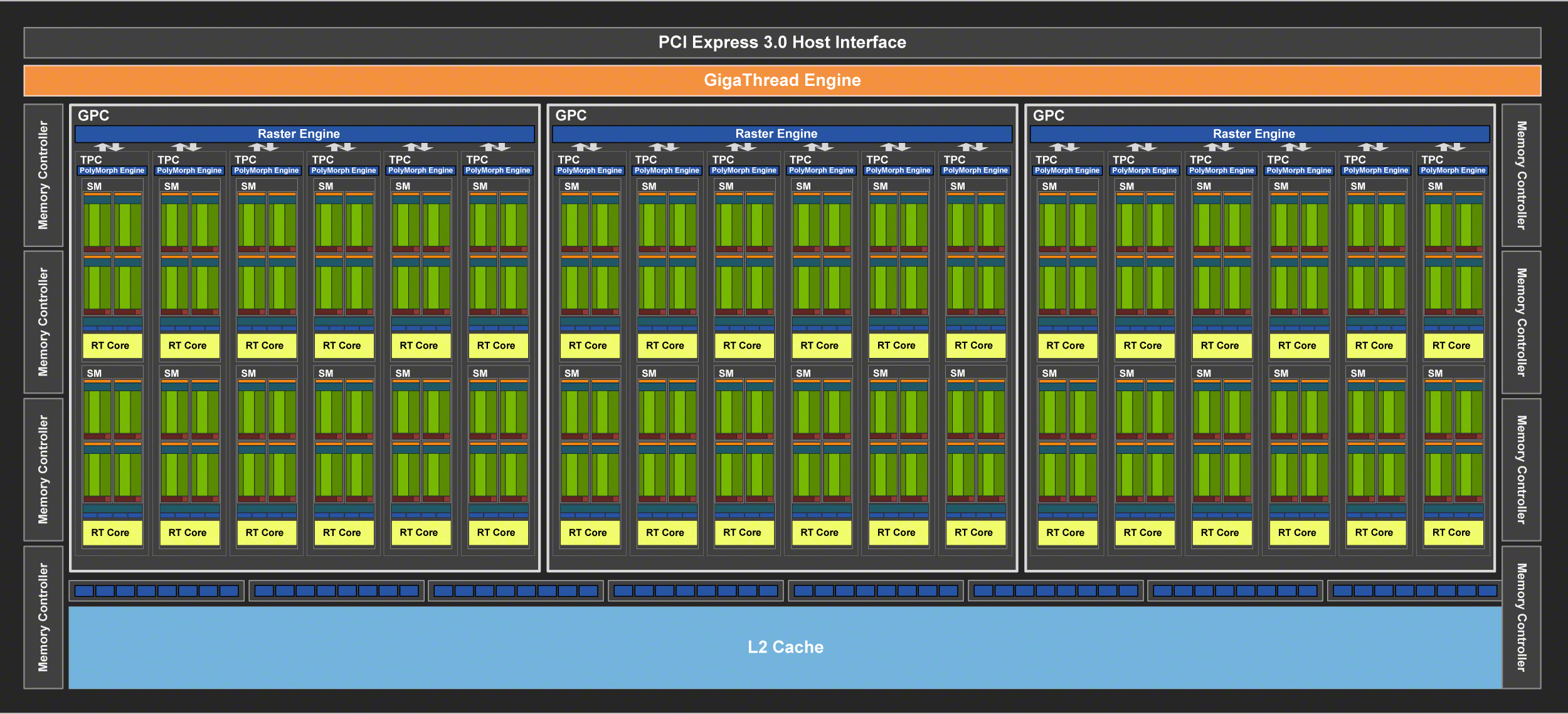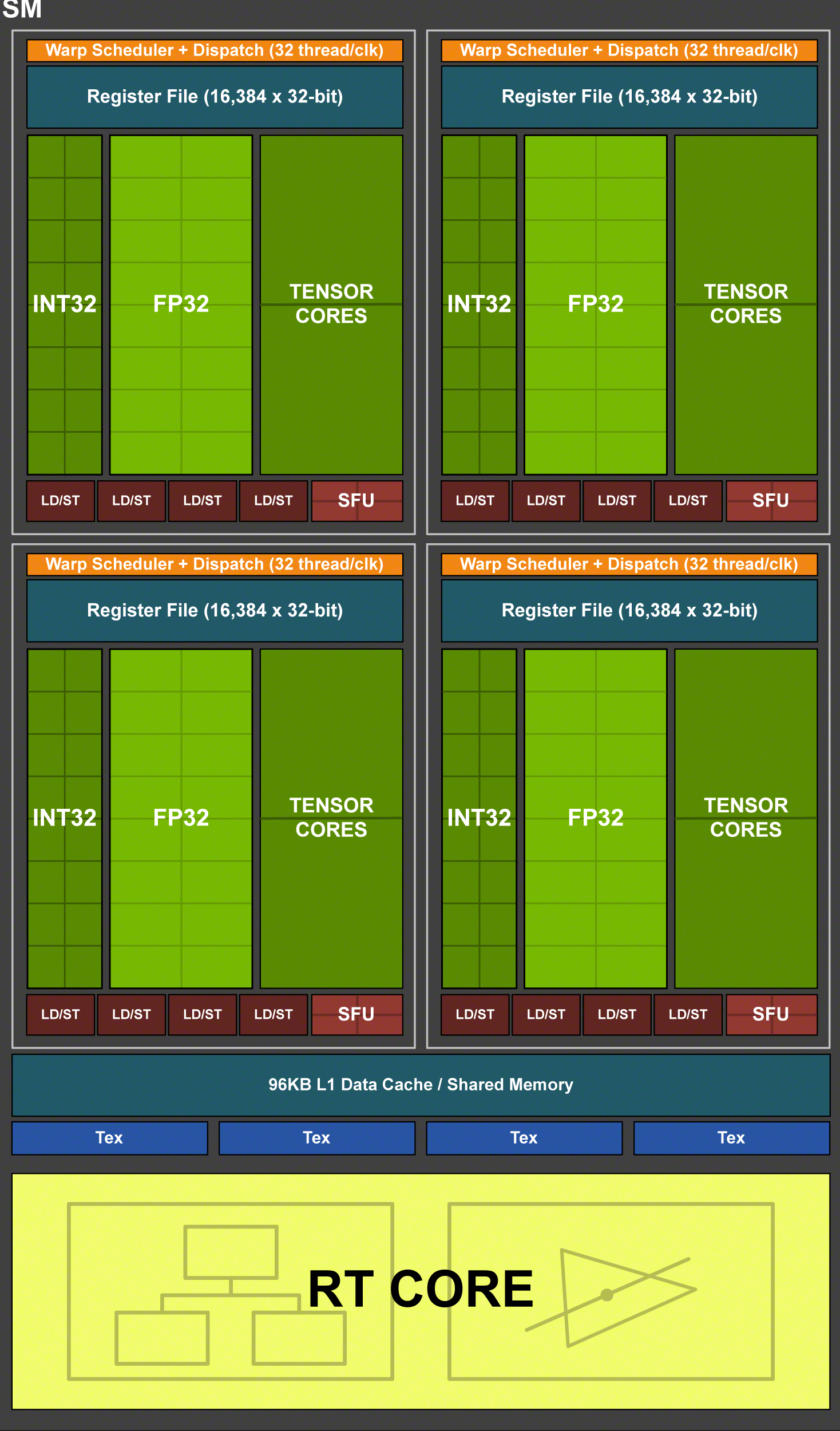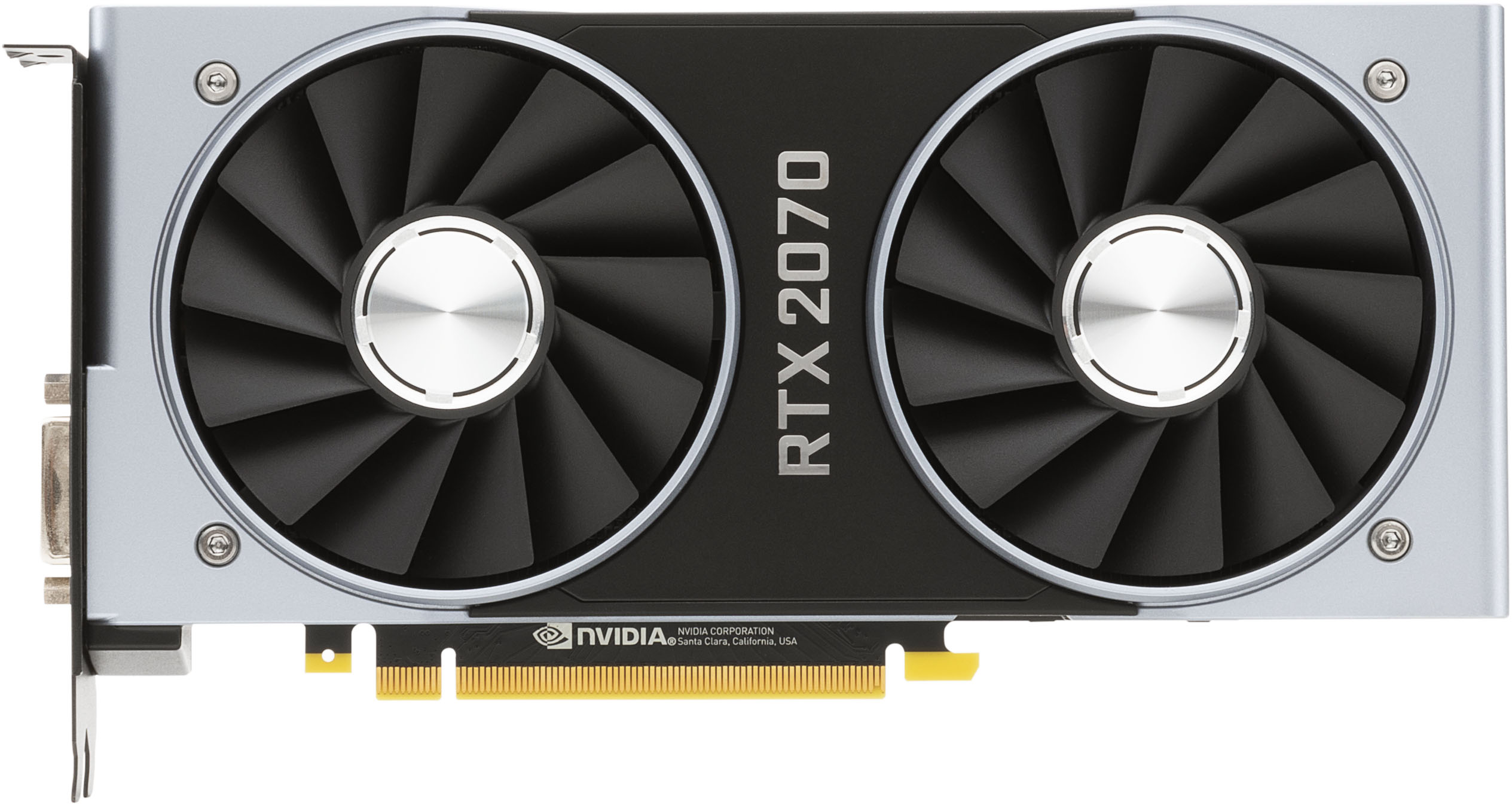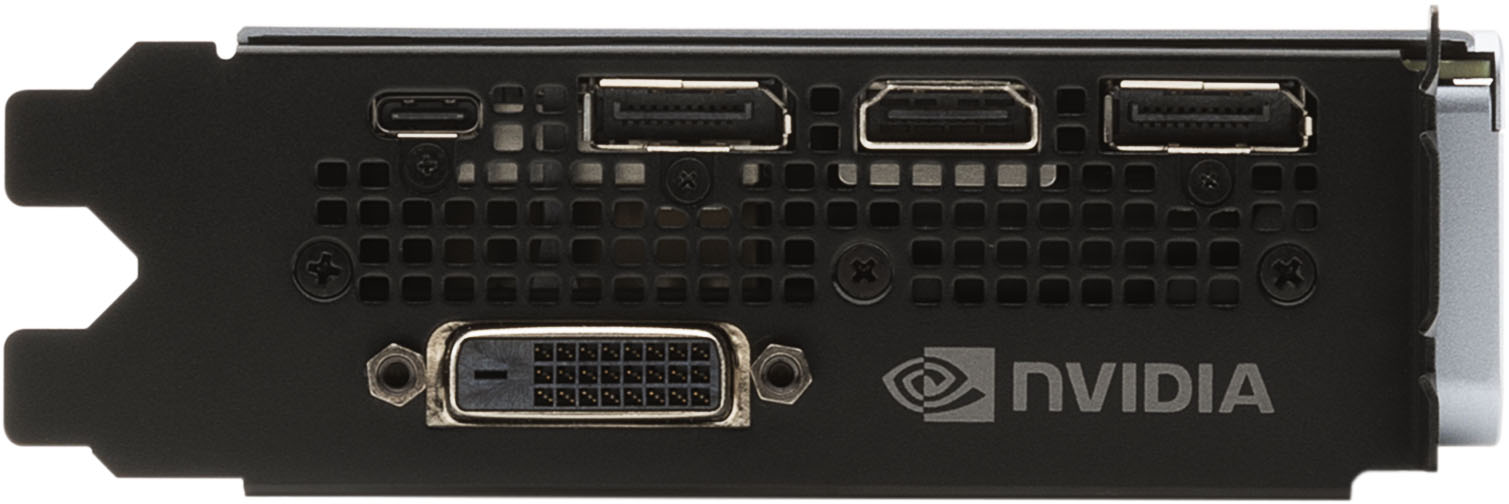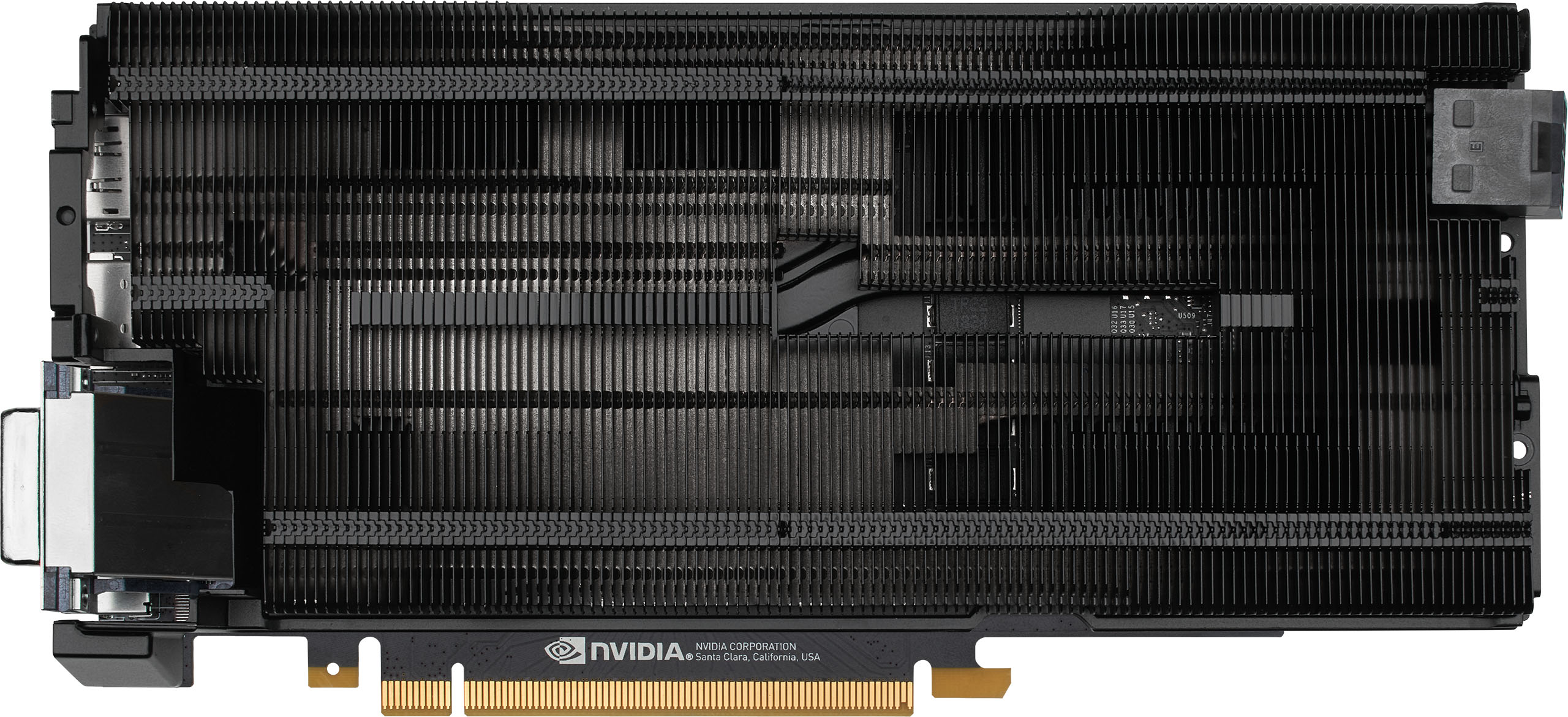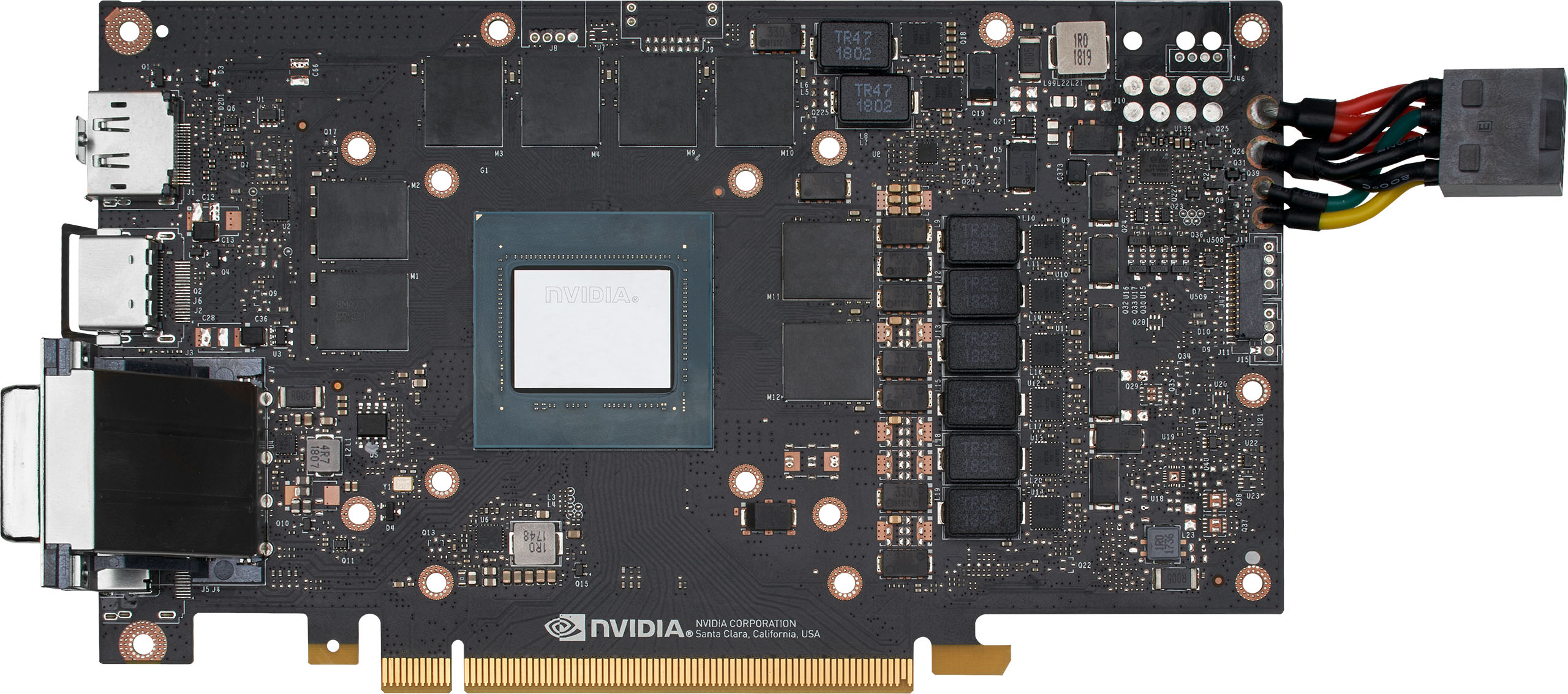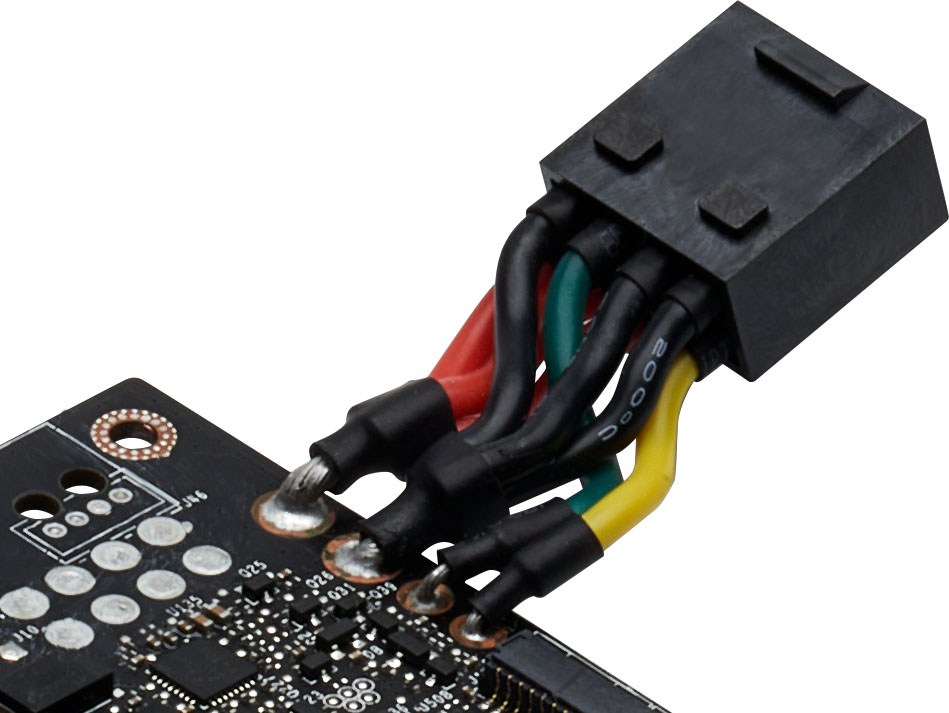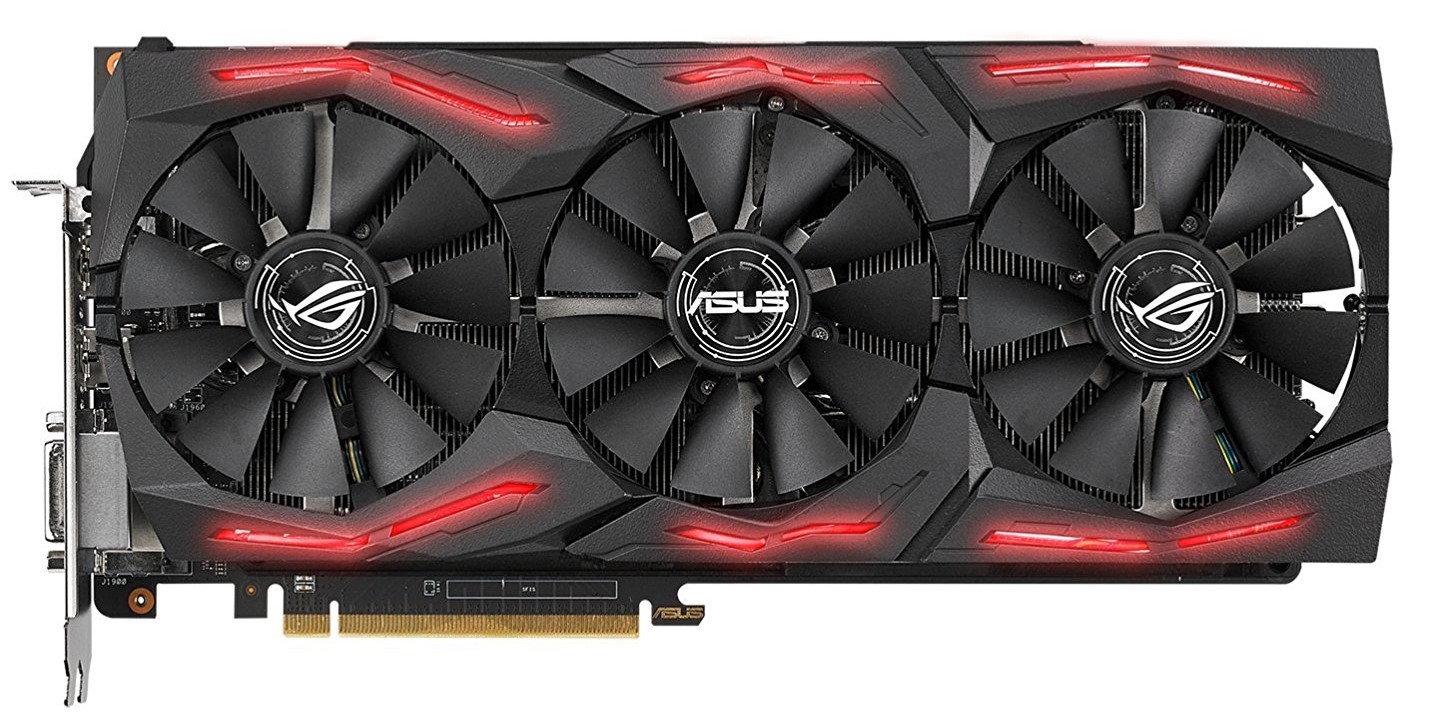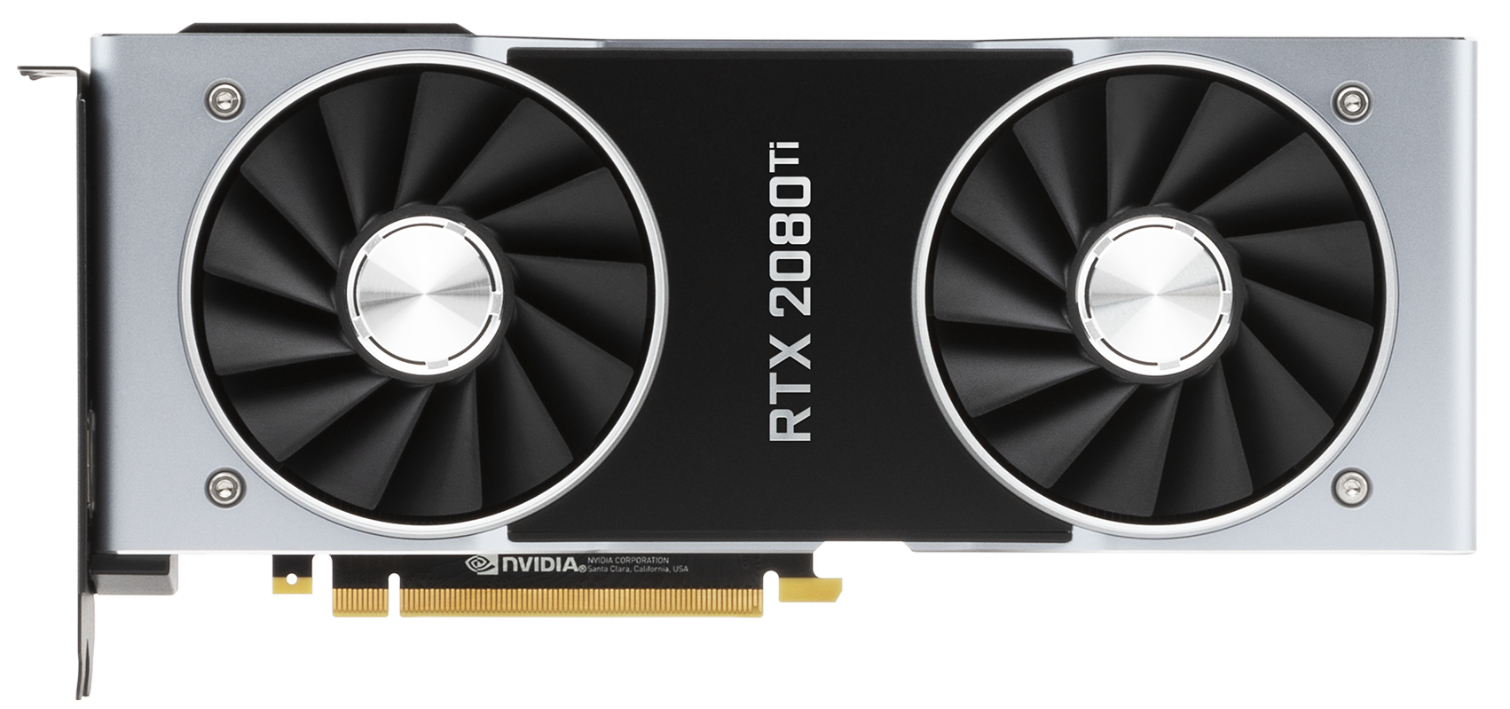Tom's Hardware Verdict
Nvidia's GeForce RTX 2070 is another well-built graphics card that offers notably higher frame rates than GeForce GTX 1080. However, it's still intended for gaming at 2560x1440, and a $600 price tag is awfully expensive for smooth QHD performance. Third-party versions will almost assuredly offer much better value, albeit at lower clock rates.
Pros
- +
Faster than GeForce GTX 1080
- +
High-quality Founders Edition design
- +
Quiet acoustics, even under load
- +
Axial fans keep GP106 processor nice and cool
Cons
- -
$600 price tag is too high compared to GeForce GTX 1080 and RTX 2070 partner boards
- -
Thermal solution blows waste heat back into your chassis
Why you can trust Tom's Hardware
Meet TU106: The Engine Powering GeForce RTX 2070
GeForce RTX 2070 is Nvidia’s third card based on its Turing architecture. And one month after introducing GeForce RTX 2080 and 2080 Ti, the company is also juggling a third Turing-based graphics processor: TU106.
To nobody’s surprise, GeForce RTX 2070 slots in just above where GeForce GTX 1080 left off. Specifically, Nvidia says its new TU106-powered board is faster than GTX 1080 in every game at 1080p, 1440p, and 4K. And across our benchmark suite, Nvidia’s claim does hold up.
The real question is whether GeForce RTX 2070 Founders Edition can justify its $600 price tag versus the $550 GeForce GTX 1080 Founders Edition, any of the sub-$500 partner cards, or AMD’s Radeon RX Vega 64, which also starts at $500. If not, third-party GeForce RTX 2070s should start in the $500 range, making RTX 2070 a natural replacement for GeForce GTX 1080.
Update on Third-Party RTX 2070 Pricing
New that RTX 2070 cards are showing up on virtual store shelves, we’re seeing a few third-party cards selling for as low as $499, which is Nvidia’s suggested starting price. Those looking for “value-priced” 2070 cards can look to cards like the Gigabyte RTX 2070 Windforce 8G or the Asus Turbo RTX 2070 8GB. Just keep in mind that cards may go in and out of stock, and if that is consistently low, prices of course could climb, even for these lower-end RTX 2070 models.
Meet TU106: The Engine Powering GeForce RTX 2070
GeForce RTX 2070 is built around a complete TU106 GPU. Architecturally, TU106 is very similar to GeForce RTX 2080’s TU104 and GeForce RTX 2080 Ti’s TU102 processors. Nvidia simply builds the chip using fewer of the modular blocks that go into its higher-end graphics cards. For instance, TU106 is composed of three Graphics Processing Clusters, each with six Texture Processing Clusters. GeForce RTX 2080’s TU104 comprises six GPCs, each with four TPCs. GeForce RTX 2080 Ti also employs six GPCs, except that its GPCs contain six TPCs apiece, just like TU106.
Across the Turing family, TPCs include two Streaming Multiprocessors, adding up to 36 SMs across TU106. Those blocks remain unchanged from the Turing GPUs we’ve already reviewed, so RTX 2070 ends up with 2304 CUDA cores, 288 Tensor cores, 36 RT cores, and 144 texture units. Those Tensor and RT cores are this generation’s signature features. So, if you missed our deep-dive into their purpose, be sure to check out Nvidia’s Turing Architecture Explored: Inside the GeForce RTX 2080.
| Header Cell - Column 0 | GeForce RTX 2070 FE | GeForce GTX 1080 FE | GeForce GTX 1070 FE |
|---|---|---|---|
| Architecture (GPU) | Turing (TU106) | Pascal (GP104) | Pascal (GP104) |
| CUDA Cores | 2304 | 2560 | 1920 |
| Peak FP32 Compute | 7.9 TFLOPS | 8.9 TFLOPS | 6.5 TFLOPS |
| Tensor Cores | 288 | N/A | N/A |
| RT Cores | 36 | N/A | N/A |
| Texture Units | 144 | 160 | 120 |
| Base Clock Rate | 1410 MHz | 1607 MHz | 1506 MHz |
| GPU Boost Rate | 1710 MHz | 1733 MHz | 1683 MHz |
| Memory Capacity | 8GB GDDR6 | 8GB GDDR5X | 8GB GDDR5 |
| Memory Bus | 256-bit | 256-bit | 256-bit |
| Memory Bandwidth | 448 GB/s | 320 GB/s | 256 GB/s |
| ROPs | 64 | 64 | 64 |
| L2 Cache | 4MB | 2MB | 2MB |
| TDP | 185W | 180W | 150W |
| Transistor Count | 10.8 billion | 7.2 billion | 7.2 billion |
| Die Size | 445 mm² | 314 mm² | 314 mm² |
| SLI Support | No | Yes (MIO) | Yes (MIO) |
Nvidia’s base clock rate for GeForce RTX 2070 is 1410 MHz with a GPU Boost rating of 1620 MHz. The Founders Edition model benefits from a higher power limit and capable cooling, allowing the company to push its typical GPU Boost frequency to 1710 MHz (and increase this card’s price by $100). Less expensive models won’t be as fast, though the difference shouldn’t be substantial.
Get Tom's Hardware's best news and in-depth reviews, straight to your inbox.
TU106 maintains the same 256-bit memory bus as TU104, and it’s likewise populated with 8GB of 14 Gb/s GDDR6 modules capable of moving up to 448 GB/s. A 4MB L2 cache and 64 ROPs carry over as well. The only capability blatantly missing is NVLink, which isn't supported on RTX 2070.
Although TU106 is the least-complex Turing-based GPU at launch, its 445 mm² die contains no fewer than 10.8 billion transistors. That’s still enormous for what Nvidia might have once considered the middle of its portfolio. In comparison, GP106—“mid-range Pascal”—was a 200 mm² chip with 4.4 billion transistors inside. GP104 measured 314 mm² and included 7.2 billion transistors. Targeting greater-than GTX 1080 performance levels, RTX 2070 really does seem like an effort to drive Tensor and RT cores as deep as possible down the chip stack, while keeping those features useful. It’ll be interesting to see how practical they remain in almost-halved quantities versus RTX 2080 Ti once optimized software becomes available. Unfortunately, a month after Turing’s debut, we still have nothing more than tech demos, breathtaking though they may be, to show what the architecture can do.
Pumped-up die size aside, reference GeForce RTX 2070 cards based on TU106 have a 175W TDP. The Founders Edition board we have in our lab is rated for 185W. GeForce GTX 1080 lands right between those two specifications at 180W.
Meet GeForce RTX 2070 Founders Edition: Making Mid-Range Turing Look Good
From the outside, GeForce RTX 2070 Founders Edition looks a lot like Nvidia’s own 2080 and 2080 Ti designs, except shorter. It’s just as tall (11.5cm) and wide (3.9cm) as the higher-end RTX board, but 23cm long instead of 27cm. More compact dimensions and a less massive cooler also cut down on heft. GeForce RTX 2070 Founders Edition weighs in at 970g to the 2080 Founders Edition’s 1250g.
Up front, it’s clear that Nvidia utilizes the same pair of 8.5cm, 13-blade axial fans, which blow through a vertically-oriented fin stack underneath. While we still miss the centrifugal fan and acrylic window of Nvidia’s previous reference cards, there’s no doubt that GeForce RTX 2070 Founders Edition is sturdily-built using high-quality materials.
Flipped over, a plate covers the back of the PCB and wraps around, touching the front shroud at both ends to create clean, unbroken lines. The backplate makes direct contact with several board components with thermal pads in between to facilitate better heat transfer.
The top of this card is far less interesting than GeForce RTX 2080 Founders Edition or 2080 Ti Founders Edition. Because the GeForce RTX 2070 does not support SLI over NVLink, there is no interface up there. Further, auxiliary power input moves to the back, presenting a cleaner aesthetic in windowed cases.
A single eight-pin power connector on the back should pose no fitment issues. Because RTX 2070 Founders Edition is on the short side, a cable coming out of its back won’t bump up against low-hanging hard drive cages. And it sure looks better than a connector jutting forward.
Gamers buying the highest-end graphics cards are more likely to own monitors with modern display inputs. At least, that’s what we get from Nvidia’s decision to arm GeForce RTX 2080 and 2080 Ti with three DisplayPort connectors and one HDMI output, while GeForce RTX 2070 Founders Edition sports two DP 1.4 interfaces, HDMI 2.0b, and a rare DVI-DL port. VirtualLink is still supported over the card’s single USB Type-C connector and, like the other GeForce RTX 2000-series cards, all four display outputs can be used at the same time for multi-monitor arrays.
With its fan shroud disconnected, GeForce RTX 2070’s heat sink stretches from one end of the card, past the 19cm-long PCB, and to the stabilizing frame’s other side. The cable for both fans and lighting runs through that channel in the middle, where the circuit board is visible, to a connector underneath. Whereas GeForce RTX 2080 and 2080 Ti shared a common thermal solution, GeForce RTX 2070 Founders Edition employs a copper sink topped by pipes that dissipate heat through all of those fins.
Remove all of its screws and the heat sink lifts up off of the frame. That frame is held tight to the PCB by hex-head screws. Once you get them off, the frame can be carefully lifted off. Just be careful to not damage the thermal pads.
GeForce RTX 2070’s power requirements aren’t as exacting as 2080’s or 2080 Ti’s, so the smaller PCB is understandably less complicated. Around back, we noticed that this board is manufactured by TTM Technologies in Hong Kong, rather than the usual Chinese-made PCBs. Nvidia did something similar with its GeForce GTX 1060 Founders Edition card, which turned out to be a very limited product. We suspect the 2070 Founders Edition is destined for a similar fate, satisfying some demand as partners ramp up everything from lower-cost 2070s to fancier overclocked versions. For now, this card covers Nvidia’s bases since board partners seemingly weren’t ready for today’s launch.
The reference design employs six power phases for TU106 and two for the GDDR6. While uPI’s uP9512 can technically control eight phases, it’s easily adapted to GeForce RTX 2070’s less sophisticated power supply. A simpler uP1666Q two-phase buck controller is ample for the memory.
Gone are the ON Semiconductor FDMF3170 Smart Power Stage modules with integrated PowerTrench MOSFETs and driver ICs, found on GeForce RTX 2080 and 2080 Ti. They’re replaced with cheaper NCP302155s featuring high- and low-side MOSFETs, plus a driver. Current to the GPU is smoothed by the usual 220mH coils, while the memory similarly employs 470mH inductors.
Getting the power connector rotated 90 degrees and extended out the back of this card’s frame required an extension of sorts. Again, that’s similar to GeForce GTX 1060 Founders Edition. Except this time, rather than a six-pin connector delivering ~5.2A of current, the eight-pin connector serves up ~11.1A through those three red +12V lines. It seems unavoidable that this area would heat up quite a bit more than previous designs employing the same remote connector.
How We Tested GeForce RTX 2070
Nvidia’s latest and greatest will no doubt be found in one of the many high-end platforms now available from AMD and Intel. Our graphics station still employs an MSI Z170 Gaming M7 motherboard with an Intel Core i7-7700K CPU at 4.2 GHz, though. The processor is complemented by G.Skill’s F4-3000C15Q-16GRR memory kit. Crucial’s MX200 SSD remains, joined by a 1.4TB Intel DC P3700 loaded down with games.
As far as competition goes, the GeForce RTX 2070 goes up against the GeForce GTX 1080 and Radeon RX Vega 64. Both are, of course, included in our benchmark results, along with the GeForce RTX 2080 Ti, GeForce RTX 2080, Titan V, GeForce GTX 1080 Ti, Titan X, GeForce GTX 1070 Ti, and GeForce GTX 1070 from Nvidia. AMD is also represented by the Radeon RX Vega 56. All cards are either Founders Edition or reference models. We do have some partner boards in-house from both Nvidia and AMD, and plan to use those for third-party reviews.
Our benchmark selection now includes Ashes of the Singularity: Escalation, Battlefield 1, Civilization VI, Destiny 2, Doom, Far Cry 5, Forza Motorsport 7, Grand Theft Auto V, Metro: Last Light Redux, Rise of the Tomb Raider, Tom Clancy’s The Division, Tom Clancy’s Ghost Recon Wildlands, The Witcher 3 and World of Warcraft: Battle for Azeroth.
The testing methodology we're using comes from PresentMon: Performance In DirectX, OpenGL, And Vulkan. In short, these games are evaluated using a combination of OCAT and our own in-house GUI for PresentMon, with logging via GPU-Z.
All of the numbers you see in today’s piece are fresh, using updated drivers. For Nvidia, we’re using build 416.33 for GeForce RTX 2070, and 411.51 for GeForce RTX 2080 Ti and 2080. The other cards are tested with build 398.82. Titan V’s results were spot-checked with 411.51 to ensure performance didn’t change. AMD’s cards utilize Crimson Adrenalin Edition 18.8.1, which was the latest at test time.
MORE: Best Graphics Cards
MORE: Desktop GPU Performance Hierarchy Table
MORE: All Graphics Content
Current page: Meet TU106: The Engine Powering GeForce RTX 2070
Next Page Deep Learning Super-Sampling: Faster Than GeForce GTX 1080 Ti?-
coolio0103 200$ more expensive a rtx 2070 than a gtx 1080 Strix or msi which is the same perfomance than the FE 2070. Bye bye 1080? Really? This page is dropped to the lowest part of the internet news pages. Bye bye Tom's hardwareReply -
80-watt Hamster Frustrating how, in two generations, Nvidia's *70-class offering has gone from $330 to $500 (est). Granted, we're talking more than double the performance, so it can be considered a good value from a strict perf/$ perpsective. But it also feels like NV is moving the goalposts for what "upper mid-range" means.Reply -
TCA_ChinChin gtx 1080 - 470$Reply
rtx 2070 - 600$
130$ increase for less than 10% fps improvement on average. Disappointing, especially with increased TDP, which means efficiency didn't really increase so even for mini ITX builds, the heat generated is gonna be pretty much the same for the same performance. -
cangelini Reply21406199 said:200$ more expensive a rtx 2070 than a gtx 1080 Strix or msi which is the same perfomance than the FE 2070. Bye bye 1080? Really? This page is dropped to the lowest part of the internet news pages. Bye bye Tom's hardware
This quite literally will replace 1080 once those cards are gone. The conclusion sums up what we think of 2070 FE's value, though. -
bloodroses Reply21406199 said:200$ more expensive a rtx 2070 than a gtx 1080 Strix or msi which is the same perfomance than the FE 2070. Bye bye 1080? Really? This page is dropped to the lowest part of the internet news pages. Bye bye Tom's hardware
Prices will come down on the RTX 2070's. GTX 1080's wont be available sooner or later. Tom's Hardware is correct on the assessment of the RTX 2070. Blame Nvidia for the price gouging on early adopters; and AMD for not having proper competition. -
demonhorde665 wow seriously sick of the elitism at tom's . seems every few years they push up what they deem "playable frame rates" . just 3 years ago they were saying 40 + was playable. 8 years ago they were saying 35+ and 12+ years ago they were saying 25+ was playable. now they are saying in this test that only 50 + is playable? . serilously read the article not just the frame scores , the author is saying at several points that the test fall below 50 fps "the playable frame rate". it's like they are just trying to get gamers to rush out and buy overpriced video cards. granted 25 fps is a bit eye soreish on today's lcd/led screens , but come on. 35 is definitely playable with little visual difference. 45+ is smooth as butterReply
yeah it would be awesome if we could get 60 fps on every game at 4k. it would be awesome just to hit 50 @ 4k, but ffs you don't have to try to sell the cards so hard. admit it gamers on a less-than-top-cost budget will still enjoy 4k gaming at 35 , 40 or 45 fps. hell it's not like the cards doing 40-50 fps are cheap them selves… gf 1070's still obliterate most consumer's pockets at $420-450 bucks a card. the fact is top end video card prices have gone nutso in the past year or two... 600 -800 dollars for just a video card is f---king insane and detrimental to the PC gaming industry as a whole. just 6 years ago you could build a decent mid tier gaming rig for 600-700 bucks , now that same rig (in performance terms) would run you 1000-1200 , because of this blatant price gouging by both AMD and nvidia (but definitely worse on nvidia's side). 5-10 years from now ever one will being saying that 120 fps is ideal and that any thing below 100 fps is unplayable. it's getting ridiculous. -
jeffunit With its fan shroud disconnected, GeForce RTX 2070’s heat sink stretches from one end of the card, past the 90cm-long PCB...Reply
That is pretty big, as 90cm is 35 inches, just one inch short of 3 feet.
I suspect it is a typo. -
tejayd Last line in the 3rd paragraph "If not, third-party GeForce RTX 2070s should start in the $500 range, making RTX 2080 a natural replacement for GeForce GTX 1080." Shouldn't that say "making RTX 2070 a natural replacement". Or am I misinterpreting "natural"?Reply -
Brian_R170 The 20-series have been a huge let-down . Yes, the 2070 is a little faster than the 1080 and the 2080 is a little faster than the 1080Ti, but they're both are more expensive and consume more power than the cards they supplant. Shifting the card names to a higher performance bar is just a marketing strategy.Reply
